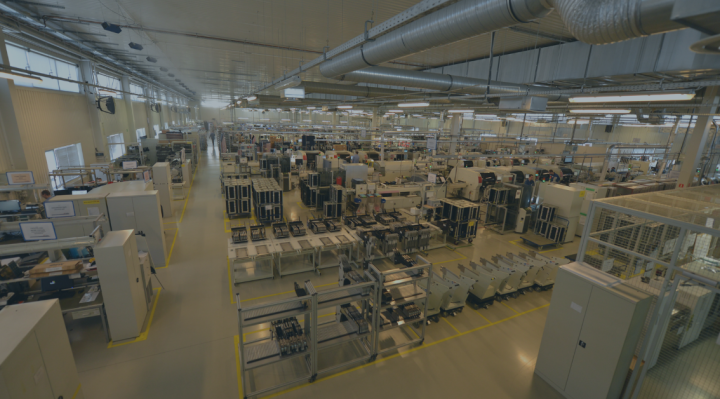What is X-Ray Inspection?
X-ray inspection, also known as radiographic inspection, is an advanced diagnostic technology that uses X-rays to create images of the internal structure of objects. It is a non-invasive method, meaning that the inspected items are not damaged in the process. This technology relies on the penetration of X-rays through different materials, which absorb the radiation to varying degrees, allowing for detailed images of internal structures to be obtained.
In electronics manufacturing, X-ray technology is widely used for quality control and the detection of defects that are invisible to the naked eye. It is particularly useful given the miniaturization and complexity of electronic components. X-ray inspection allows for a precise examination of printed circuit boards (PCBs), solder joints, and components, ensuring precision and reliability. Detectors capture images showing defects such as cracks, shorts, solder voids, and other structural abnormalities.
The technology includes various inspection systems, from simple scanners to advanced computed tomography (CT) systems capable of generating 2D and 3D images, which enable a thorough analysis of components from different perspectives. X-ray inspection can be applied at various stages of production, from incoming material inspection to final inspection of finished products. This enables quick identification and elimination of problems, increasing the quality and reliability of devices.
One key application is the quality control of surface mount technology (SMT) and through-hole technology (THT). This technology allows for the precise inspection of soldering on the surface of the boards and the analysis of barrel fills in soldering holes. By visualizing the internal structures of connections, defects affecting the functionality and durability of devices can be quickly detected and corrected.
X-ray inspection is also used to verify compliance with IPC standards, which set quality and reliability standards for electronic components. It enables detailed analysis of BGA (Ball Grid Array) connections and other advanced components, ensuring compliance with industry requirements. Additionally, X-ray technology serves to inspect the quality of supplied components, including detecting counterfeits by comparing the internal structure with original specifications. It also allows for the analysis of manufacturing errors in printed circuit boards (PCBs), enabling the quick identification and elimination of defective batches.
Applications of X-Ray Inspection
X-ray inspection has a wide range of applications in electronics manufacturing, offering benefits in many areas. Key applications include:
1. Detection of Assembly Accuracy: X-ray inspection allows for the verification of barrel fills and the accuracy of assembly in hidden areas, both in SMT and THT. It can detect issues such as improper fill of solder via, preventing functional and mechanical problems.
2. Verification of Compliance with IPC Standards: X-ray inspection ensures that BGA connections and other components meet IPC standards, preventing problems related to improper assembly, such as solder bridges and voids.
3. Support for New Product Introduction: X-ray inspection facilitates the verification of production parameters for new products and the correctness of component soldering, speeding up market introduction and minimizing the risk of manufacturing defects.
4. Authenticity Analysis of Components: X-ray inspection is useful in detecting counterfeits by comparing the internal structure of components with original specifications, which is crucial for product reliability.
5. Detection of PCB Supplier Errors: X-ray technology allows for a detailed analysis of printed circuit boards, identifying defects such as cracks and shorts, thus enhancing the quality and reliability of finished products.
Limitations of X-Ray Technology
While X-ray technology brings numerous benefits to electronics manufacturing, it also has some limitations. The main challenge is the risk of damaging components sensitive to X-ray radiation, such as semiconductor memories (RAM, EEPROM), microcontrollers, and other integrated circuits. High doses of radiation can degrade their internal structure.
Sensitive components include those with delicate structures and low resistance, such as certain sensors, transistors, and photovoltaic elements. Precautions and power calibration are key to minimizing the risk of damage.
Operator experience is also crucial for effective and safe inspection. Handling X-ray systems requires training and knowledge of calibration and image interpretation. Lack of experience can lead to errors in interpreting results and damaging components.
Appropriate power selection is another critical limitation. Excessive power can overexpose components, distorting results and causing damage, while insufficient power may not provide high-quality images for defect identification.
Costs and availability of X-ray technology are also barriers. X-ray systems are expensive to purchase and maintain, which can be a problem for smaller companies. Sometimes, inspections must be outsourced to external firms, adding to costs.
Physical limitations of X-ray technology also exist. Some defects may be difficult to detect or interpret, especially in complex electronic designs. Sometimes additional inspection methods or a combination of techniques are necessary to obtain a complete picture of component quality.
X-Ray Image Evaluation
Evaluating X-ray images is a crucial stage in radiographic inspection in electronics manufacturing, involving the analysis and interpretation of images to identify defects. It requires advanced equipment and the expertise of inspectors who understand the principles of X-ray technology, how radiation penetrates materials, and how images are created.
Inspectors must be able to distinguish correct structures from defects such as cracks, voids, shorts, or soldering errors. The analysis often requires comparing images with reference ones and assessing from various angles to ensure detected anomalies are actual defects. Experienced inspectors minimize the risk of false alarms, ensuring high-quality components.
Familiarity with industry standards, such as IPC, is important to assess whether components meet quality requirements. X-ray inspection not only diagnoses but also ensures compliance with manufacturing standards.
Proficiency in operating X-ray systems, which offer 2D and 3D modes, automatic defect detection, and dynamic analysis, is essential. Inspectors must stay updated with technological advancements and inspection methods to effectively and accurately conduct inspections.
Evaluating X-ray images is a multistep process requiring advanced technology and inspector skills. Each image must be thoroughly analysed, and in case of doubts, inspectors may consult with other specialists or use additional analytical tools to ensure the highest quality and reliability of produced electronic devices.







